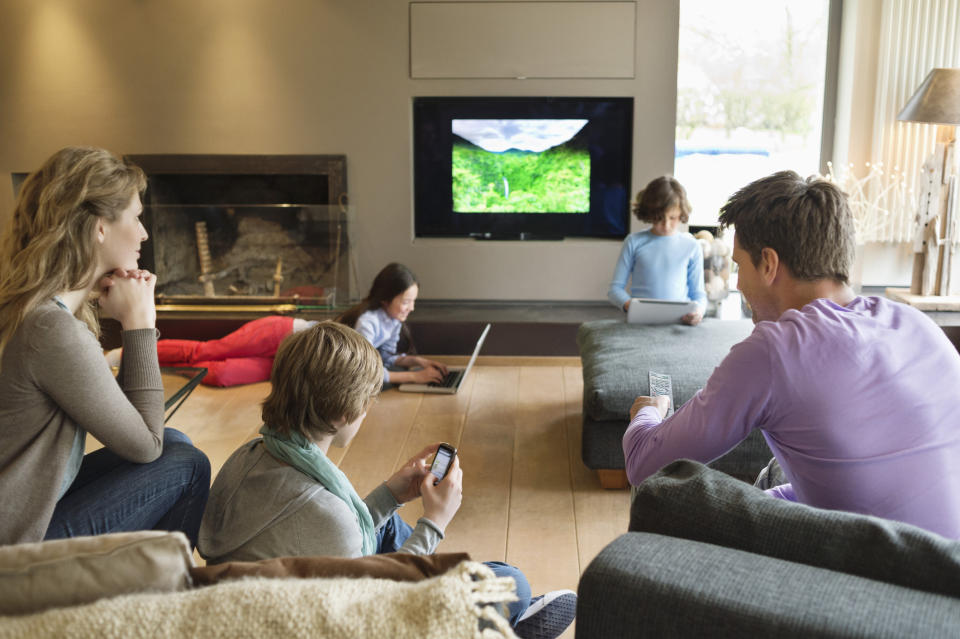8 energy-saving tips you can teach your kids to shave hundreds off your power bill

Here’s a different way of thinking about your household energy usage: it’s not about what is being used, but who’s using it.
Well, it turns out a majority of Aussies are pointing the finger at their offspring – particularly teens and young adults – as being the greatest power guzzlers at home thanks to their use of screens, according to a survey by comparethemarket.com.au.
“Whether it is keeping lights or TVs on when they leave the room, blasting the air conditioner, or throwing just one item in the washing machine, kids are notorious energy wasters,” said comparethemarket.com.au banking general manager Rod Attrill.
But families can save hundreds a year on energy bills – and reduce their carbon footprint at the same time – with a few handy energy-saving tricks.
And they’re so simple that you can even teach your kids.
1. Don’t charge your screens all night
We’re using our screens so much during the day that we’re in the habit of charging them all through the night. But it only costs two hours to fully recharge an iPhone, Attrill pointed out – so unplug chargers at the wall to avoid unnecessary power usage and bulkier bills.
2. Switch things off at the wall
Even if we’re not using lamps, electric clocks, or mobile phone chargers, they’re still drawing power. “Other electronics on standby power can account for more than 10 per cent of your electricity use,” Attrill said. Turn electronics off at the wall and you could save up to $193 a year.
3. Turn the TV off when you leave the room
Kids can have the bad habit of leaving the TV on when they leave the room – but this habit needs to be broken! To top it off, the bigger the screen, the more energy you use. When you upgrade TV screens, be sure to ask for its standby energy score.
4. Only wash full loads
A half-empty load of washing uses the same energy as a full load, so ensure everyone in the family waits until a full load accumulates before hitting start on the machine. Note that this principle also applies to dryers and dishwashers, too.
5. Hang your clothes when you can
Hanging your clothes where you can instead of throwing them in the dryer can save around $79 a year, Attrill pointed out.
“If kids do use the dryer, teach them how to use it efficiently, such as to avoid placing dripping wet clothes in the dryer, and not scheduling it to run for longer than needed.”
6. Get them to understand household bills
Just as teaching your kids chores and pocket money will teach them the value of hard work and saving, getting your kids involved in reviewing household bills will help them understand the costs you face.
“It’ll also stand them in good stead for when they have to pay their own bills,” Attrill said.
7. Monitor screen times
Set a limit to your kids’ daily screen time – you decide how much – and encourage them to enjoy the great outdoors more. Consider pulling TVs, computers and gaming devices from their rooms to shared spaces in the home to make it easier to monitor how much time is spent sitting in front of screens.
8. The aircon temperature doesn’t have to be set to freezing
Studies have shown that the optimum temperature for your aircon is actually 25 degrees – meaning that lower temperatures aren’t really doing much more than putting you hundreds of dollars out of pocket. Teach your kids to close the doors when the aircon is on and to turn it off when no one’s home.
Make your money work with Yahoo Finance’s daily newsletter. Sign up here and stay on top of the latest money, news and tech news.
Now read: This aircon mistake is costing Aussies $200
Read next: The free tool Aussies are using to save $1,600 on their energy bills
Read next: High energy bills will cost the Aussie economy $8.5 billion: here’s why

 Yahoo Finance
Yahoo Finance 
